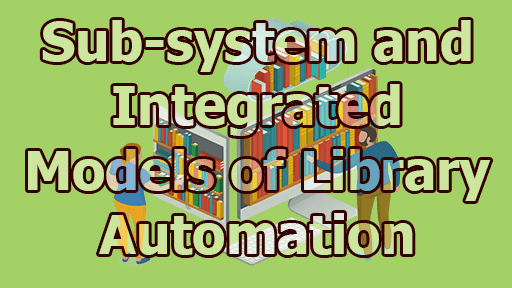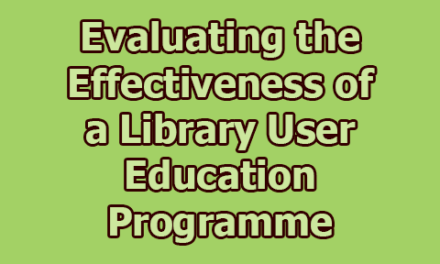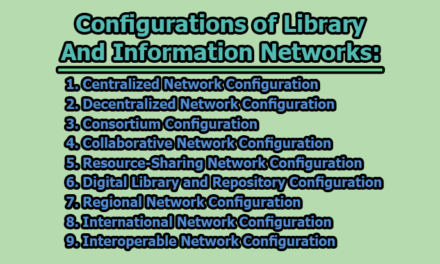Sub-system and Integrated Models of Library Automation:
Library automation plays a pivotal role in modernizing library operations, enhancing efficiency, and improving user services. Two prominent approaches within this realm are sub-system models and integrated models of library automation. Sub-system models involve the use of specialized software or systems to manage specific functions or tasks within a library, each dedicated to a particular aspect of library operations. In contrast, integrated models consolidate various library functions into a unified, centralized software platform, promoting seamless workflows, data integrity, and enhanced user experiences. This article will explore the sub-system and integrated models of library automation, shedding light on their unique features, benefits, and relevance in the evolving landscape of library technology.
Sub-System Models of Library Automation:
Sub-system models of library automation involve the use of separate, specialized software or systems to manage specific functions or tasks within a library. Each sub-system is designed to handle a particular aspect of library operations, and together, they create a comprehensive library automation environment. Let’s explore these sub-systems:
1. Cataloging and Classification System:
a) Purpose: This sub-system is responsible for organizing and describing library materials, making it easier for users to locate and access items in the collection.
b) Functions:
- Cataloging: Creating bibliographic records for each item in the library, including information like title, author, subject, and call number.
- Classification: Assigning call numbers based on a classification scheme like the Dewey Decimal Classification or Library of Congress Classification.
- Indexing: Creating indexes to facilitate keyword-based searching.
c) Software: Libraries commonly use software like MARC (Machine-Readable Cataloging) and AACR2 (Anglo-American Cataloging Rules) for cataloging and classification.
2. Circulation System:
a) Purpose: The circulation sub-system manages the borrowing, renewing, and returning of library materials by patrons.
b) Functions:
- Patron Registration: Creating and updating patron accounts, including contact information and borrowing privileges.
- Check-out and Check-in: Recording when items are borrowed and returned, updating item availability.
- Holds and Reservations: Managing patron requests to reserve or place holds on items.
- Overdue and Fine Management: Tracking due dates, calculating fines for late returns, and sending notifications to patrons.
c) Software: Integrated library systems (ILS) often include circulation modules to handle these functions.
3. Acquisitions System:
a) Purpose: The acquisitions sub-system automates the process of procuring new materials for the library’s collection.
b) Functions:
- Ordering: Creating purchase orders for books, journals, and other materials.
- Receiving: Recording the arrival of ordered items and verifying their condition.
- Invoicing: Handling payments to vendors and updating the library’s financial records.
c) Software: Acquisitions modules within ILS or standalone acquisitions systems are used for this purpose.
4. Serials Management System:
a) Purpose: Libraries with periodical collections use this sub-system to efficiently manage subscriptions and serials.
b) Functions:
- Subscription Tracking: Managing subscription details, including start and end dates, frequency, and format (print or electronic).
- Issue Check-in: Recording the receipt of serial issues, ensuring that the library has all the expected volumes.
- Claims for Missing Issues: Automating the process of claiming missing issues from publishers.
c) Software: Standalone serials management systems or integrated modules are used.
5. Interlibrary Loan (ILL) System:
a) Purpose: The ILL sub-system facilitates resource sharing between libraries, allowing patrons to access materials not available in the local collection.
b) Functions:
- Request Processing: Managing patron requests for materials not owned by the library.
- Borrowing and Lending: Handling the borrowing and lending of materials with other libraries.
- Tracking and Notifications: Monitoring the status of ILL requests and notifying patrons when items are available.
c) Software: Specialized ILL systems or ILL modules within ILS are used for interlibrary loan operations.
6. OPAC (Online Public Access Catalog):
a) Purpose: While not a traditional sub-system, the OPAC serves as the public-facing interface for library users to search the catalog and access services.
b) Functions:
- Search and Discovery: Allowing patrons to search for library materials using keywords, authors, or subject terms.
- Item Availability: Displaying information about item availability, location, and call number.
- Account Management: Enabling patrons to manage their borrowing, renew materials, and place holds.
c) Software: OPACs are typically integrated with the library’s catalog and circulation system.
7. Digital Library System:
a) Purpose: For libraries with digital collections, this sub-system manages the organization, storage, and access of digital resources, including eBooks, eJournals, digitized historical documents, multimedia materials, and more.
b) Functions:
- Digital Asset Management: Storing, cataloging, and preserving digital assets.
- User Authentication: Ensuring secure access to digital resources.
- Metadata Creation: Describing digital items with metadata, such as titles, authors, and keywords.
- Search and Retrieval: Allowing users to search and access digital content seamlessly.
- Digital Rights Management (DRM): Managing copyright and access permissions for digital materials.
c) Software: Digital library systems like DSpace, CONTENTdm, and Hydra/Fedora are commonly used.
8. Resource Discovery and Federated Search:
a) Purpose: These sub-systems enhance the user’s ability to find resources beyond the library’s catalog by searching multiple databases and repositories simultaneously.
b) Functions:
- Federated Searching: Aggregating search results from various databases and catalogs.
- Faceted Searching: Allowing users to refine search results using facets like format, date, subject, and more.
- Resource Linking: Providing direct access to full-text resources.
c) Software: Libraries often use federated search tools integrated with their catalog or discovery platforms.
9. Institutional Repository System:
a) Purpose: Universities and research institutions use this sub-system to manage and provide access to their academic and research output.
b) Functions:
- Archiving: Storing and preserving research papers, theses, and other scholarly works.
- Open Access: Making research outputs freely available to the public.
- Metadata Management: Describing and indexing items with rich metadata.
- Version Control: Managing multiple versions of research materials.
c) Software: Popular repository systems include DSpace, EPrints, and Digital Commons.
10. Reference and Information Management:
a) Purpose: This sub-system supports reference services and information management within the library.
b) Functions:
- Reference Desk Integration: Managing reference requests, queries, and consultations.
- Knowledge Base: Maintaining a knowledge base of frequently asked questions and resources.
- Document Delivery: Facilitating document delivery services for patrons.
c) Software: Some libraries integrate reference and information management tools with their library systems or use specialized reference software.
11. Analytics and Reporting:
a) Purpose: Libraries use this sub-system to gather, analyze, and report on data related to library operations and usage patterns.
b) Functions:
- Data Collection: Gathering statistics on circulation, catalog searches, resource usage, and more.
- Report Generation: Creating custom reports and dashboards for library staff and stakeholders.
- Usage Analysis: Assessing the performance of library collections and services.
c) Software: Libraries may use dedicated analytics and reporting tools or features provided by integrated library systems.
Integrated Models of Library Automation:
Integrated models of library automation, also known as Library Management Systems (LMS) or Library Information Systems (LIS), represent a comprehensive and unified approach to automating library operations. In this model, various library functions are tightly integrated into a single, centralized software platform. This integration allows for seamless workflows, improved efficiency, and enhanced services for both library staff and patrons. Let’s explore the components and features of integrated models.
1. Integrated Database:
a) Purpose: The integrated database is the heart of the integrated library system (ILS). It stores all library-related data, such as bibliographic records, patron information, circulation transactions, and acquisitions details, in a structured and centralized manner.
b) Features:
- MARC Records: Storing and managing cataloging information following the MARC format.
- Authority Control: Ensuring consistency in author and subject headings.
- Metadata Management: Supporting rich metadata for various types of materials.
c) Benefits:
- Data integrity: Eliminating duplication and ensuring data consistency.
- Efficient data retrieval for library operations.
2. Centralized Administration:
a) Purpose: The centralized administrative interface empowers library staff to efficiently manage all aspects of library operations from a single location.
b) Functions:
- User Management: Creating, modifying, and deactivating patron accounts, assigning user privileges, and managing user roles.
- Collection Management: Cataloging, classifying, and updating library materials, including adding, deleting, or editing records.
- Circulation Management: Handling check-in, check-out, renewals, and managing holds, overdues, and fines.
- Acquisitions and Budgeting: Managing the acquisition of new materials, tracking budgets, and processing invoices.
c) Benefits:
- Streamlined workflows for library staff.
- Reduced training time for new staff members.
- Enhanced data security and access controls.
3. Seamless Workflows:
a) Purpose: Integrated models promote seamless workflows by automating processes and ensuring data consistency across library functions.
b) Examples:
- A book cataloged in the system automatically becomes available for circulation without manual intervention.
- Patron records are instantly updated when they borrow or return items.
c) Benefits:
- Minimized manual data entry errors.
- Faster service delivery and reduced wait times for patrons.
4. Enhanced Reporting and Analytics:
a) Purpose: Integrated systems offer robust reporting and analytics tools to help libraries gather insights into their operations and make data-driven decisions.
b) Features:
- Custom Reporting: Libraries can create tailored reports based on specific criteria.
- Data Visualization: Charts, graphs, and visual representations of data for easier comprehension.
- Usage Metrics: Tracking circulation statistics, patron behavior, and collection performance.
c) Benefits:
- Informed decision-making for collection development.
- Evidence-based planning and resource allocation.
- Improved library services based on patron behavior analysis.
5. Patron Services:
a) Purpose: Integrated models provide a unified interface for patrons to access library services and resources.
b) Functions:
- Catalog Search: Patrons can search for items across various formats (print, electronic, audio, etc.) using a single search bar.
- Account Management: Patrons can view their borrowing history, renew items online, place holds, and update their contact information.
- Interlibrary Loan (ILL): Seamless access to interlibrary loan services for requesting materials not in the library’s collection.
c) Benefits:
- Improved user experience and satisfaction.
- Increased self-service capabilities for patrons.
- Accessibility to a wider range of resources.
6. Vendor Integration:
a) Purpose: Integration with vendors streamlines the procurement process and simplifies financial transactions.
b) Functions:
- Online Ordering: Libraries can place orders for new materials directly through the system, with details automatically integrated into the acquisitions module.
- Invoice Management: Invoices from vendors can be automatically matched with purchase orders, simplifying payment processing.
c) Benefits:
- Efficient acquisition of materials.
- Accurate financial tracking and reporting.
7. Interoperability:
a) Purpose: Integrated models support interoperability standards, ensuring compatibility with other library systems and facilitating resource sharing.
b) Features:
- 50 Protocol: Allows for the exchange of catalog records between libraries.
- SIP2 (Standard Interchange Protocol): Enables integration with self-checkout machines and other library hardware.
c) Benefits:
- Enables collaboration with other libraries in a network.
- Supports the use of third-party services and products.
8. Scalability:
a) Purpose: Integrated models are designed to scale to the needs of libraries, whether they are small public libraries or large academic institutions.
b) Features:
- Modular Architecture: Libraries can add or remove modules as needed.
- Support for Multiple Libraries: ILS can serve multiple branches or locations.
c) Benefits:
- Adaptable to changes in library size and scope.
- Cost-effective for libraries of varying sizes and budgets.
In conclusion, sub-system and integrated models of library automation represent distinct yet equally valuable approaches to modernizing library operations. Sub-system models excel in offering specialized solutions for specific library functions, allowing libraries to tailor their technology to their unique needs. On the other hand, integrated models provide a comprehensive, unified system that streamlines workflows, enhances data management, and optimizes user services. The choice between these models depends on factors such as library size, budget, and specific requirements. As libraries continue to adapt to evolving technological landscapes and user expectations, both sub-system and integrated models remain essential tools in ensuring efficient and user-centric library services for the future.

Library Lecturer at Nurul Amin Degree College










